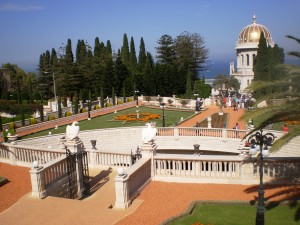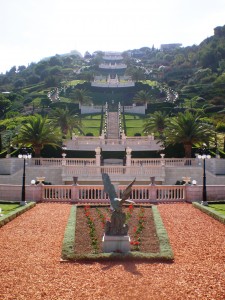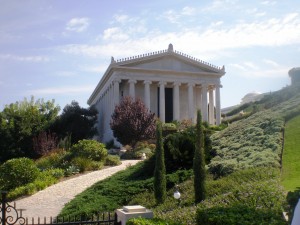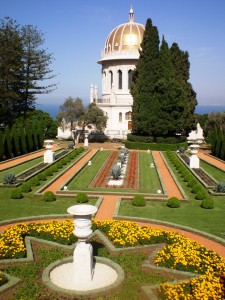According to the latest figures produced by the Central Bureau of Statistics, Israel’s population stands at just over 8 million people. Of those, 75% percent of them are Jewish, 20% are Moslem Arabs and 4.6% are Christians, leaving just over 4% of the population classified as “other”. I would like to take this opportunity to introduce you to one of these religious minorities.
The reason I have chosen to concentrate on the Bahai, even though there are very few of them in Israel, is because the Bahai gardens and shrine, stretching approximately one kilometre up the slope of Mount Carmel, are one of the better known tourist sites in the Haifa area. Although far less is known about the Bahai themselves. Modern Bahai claim they have nothing to do with Islam and consider themselves a twenty-first century religion still in the process of developing and open to new ideas. Its roots nevertheless stem from the nineteenth century when they were considered a heretic off-shoot from Shiite Islam. Today it is considered the second fastest growing religion in the world with over 7 million followers.
The break happened in 1844 in Persia (today’s Iran) when Mirza Ali Muhammad declared himself the “Bab” or “Gateway”. He proclaimed that he had been sent by G-d to pave the way for someone even greater to follow and he was the gate through which this person would come. The “Bab” also declared that his teachings would supersede those of the Quran, and he considered “pure” many things that the Quran declared to be “impure”. This was a severe break from mainstream Islam and predictably the local Shiites were none too happy about this turn of events. The Bab was imprisoned in total darkness and was eventually executed in Shiraz in 1850. He was only 31 years old. The 2,200 lamps in the gardens, each of them with a 7 watt bulb like a candle are turned on at nightfall each day. This light is to counter the 6 years the Bab was imprisoned in the dark. He had asked for candles and was refused. It is to make sure he will never be in the dark again.
In 1863, nineteen years after the Bab’s original declaration, Mirza Hussein proclaimed himself the “Baha’ulla” or “Glory of G-d”. As expected, he was also not embraced by the religious leadership. Possibly because he came from a wealthy family he was not executed on the spot, but was exiled from Iran, eventually finding himself incarcerated in the Ottoman prison in Akko (Acre) in 1868. Through his prison window he could see Mount Carmel and he had a vision of gardens on the slopes of the mountain. His followers wanted to fulfill his prophecy and that is how the gardens were conceived.
The Baha’ullah’s son, exiled together with his father, accompanied him to Akko. From there he carried out his father’s wish to transfer the bones of the Bab to Haifa. They arrived on March 21st 1909 and since then the Bahai celebrate that date as their new year. The golden shrine in the Bahai gardens contains his tomb. The Baha’ullah is buried in the lesser known Bahai gardens in Akko, but his son (Abdul Baha) is buried next to the Bab.
The land in Haifa was  already purchased in the time of the Baha’ulla, but work on building the gardens did not start until 1987 and they were opened to the public in 2001. They cost $250 million to construct, all of which came from Bahai donations. A gift of $1 million offered by Amram Mitzna, then mayor of Haifa, was rejected because the Bahai do not accept donations from non-Bahai. For that reason, the gardens are open to the public free of charge. However, they did request a change to enhance the view from the gardens. In 2001 a street in the German Colony of Haifa was moved 168 cm to the left, to maintain a symmetrical line between the golden shrine and Akko where the Baha’ulla is buried.
already purchased in the time of the Baha’ulla, but work on building the gardens did not start until 1987 and they were opened to the public in 2001. They cost $250 million to construct, all of which came from Bahai donations. A gift of $1 million offered by Amram Mitzna, then mayor of Haifa, was rejected because the Bahai do not accept donations from non-Bahai. For that reason, the gardens are open to the public free of charge. However, they did request a change to enhance the view from the gardens. In 2001 a street in the German Colony of Haifa was moved 168 cm to the left, to maintain a symmetrical line between the golden shrine and Akko where the Baha’ulla is buried.
Neither the Quran or the Bible are included in Bahai scriptures and the religion is based on books written by the Bab and the Baha’ullah. They are a monotheistic faith and believe G-d sent new prophets or messengers to earth. They believe in all of the prophets including Moses and Jesus, Buddah and Krishna, but maintain that the Baha’ullah was the last one. The Bahai took their name from him as “Baha” means “glory”. Men and women are considered equal and acceptance of the Bahai religion is a voluntary act carried out in one’s teens. There is a tremendous emphasis on unity with a belief that the globe is one city and one day it will be united and speak a universal language. Once a day every Bahai is required to pray and faces towards Akko to do so.
The Bahai year consists of 19 months, each of which is 19 days, which makes a total of 361 days with 4 left for holidays. At least once in a lifetime a Bahai must make a pilgrimage to Akko and to Haifa. Both alcohol and drugs are forbidden, although cigarettes and medications are permitted. Charity is obligatory and the whole movement is supported by these donations.
Every year there are elections where voting is carried out over the internet. Out of up to 200 candidates only 9 leaders are chosen. These leaders choose 9 counselors and they in turn choose 180 counselors for the whole world. The 9 leaders and 9 first counselors work and live in the Universal House of Justice which is one of the buildings in the gardens. In addition, 800 volunteers come for two years to work in the gardens and the complex. They are assisted by a small number of paid gardeners. Apart from this population there are no Bahai in Israel.
In the gardens there are 18 terraces which equal the number of leaders and first level counselors. The number 18 is significant because it commemorates the original group of followers of the Bab. Recycled rainwater circulates underneath the terraces. Visitors are allowed to descend the steps, climbing up is only for Bahai. As the Bahai pilgrims ascend, the running water is supposed to relax them and provide a meditative mood so that they can contemplate the pain and agony that was the path of the Bab until he was executed. It is interesting to note that all the colours are shades of green and orange.
One of the buildings in the gardens is the library which has seven floors, including several below ground, which contain Bahai writings and teachings. The Baha’ullah’s book has been translated into 700 languages.
However, despite the beauty, aesthetics and symmetry of all of the grounds, one’s eye is inevitably drawn to the Shrine of the Bab which is decorated with 12,000 gold plated tiles. It can only be visited by Bahai and on the wall of the shrine is inscribed “The Tablet of the Visitation” which every visitor reads. Next to it is the shrine of Abdul Baha.
 The gardens were designed by Fariburz Sahba, a Bahai architect born in Iran, now living in the US and Canada. He also designed the Bahai LotusTemple in New Delhi. He said “The Shrine of the Bab is envisaged as a precious gem, for which the terraces provide the setting, like a golden ring for a precious diamond”. Tours of the gardens are given in various languages throughout the week. Reservations are not required. The Bahai gardens in Akko are also open to visitors.
The gardens were designed by Fariburz Sahba, a Bahai architect born in Iran, now living in the US and Canada. He also designed the Bahai LotusTemple in New Delhi. He said “The Shrine of the Bab is envisaged as a precious gem, for which the terraces provide the setting, like a golden ring for a precious diamond”. Tours of the gardens are given in various languages throughout the week. Reservations are not required. The Bahai gardens in Akko are also open to visitors.
